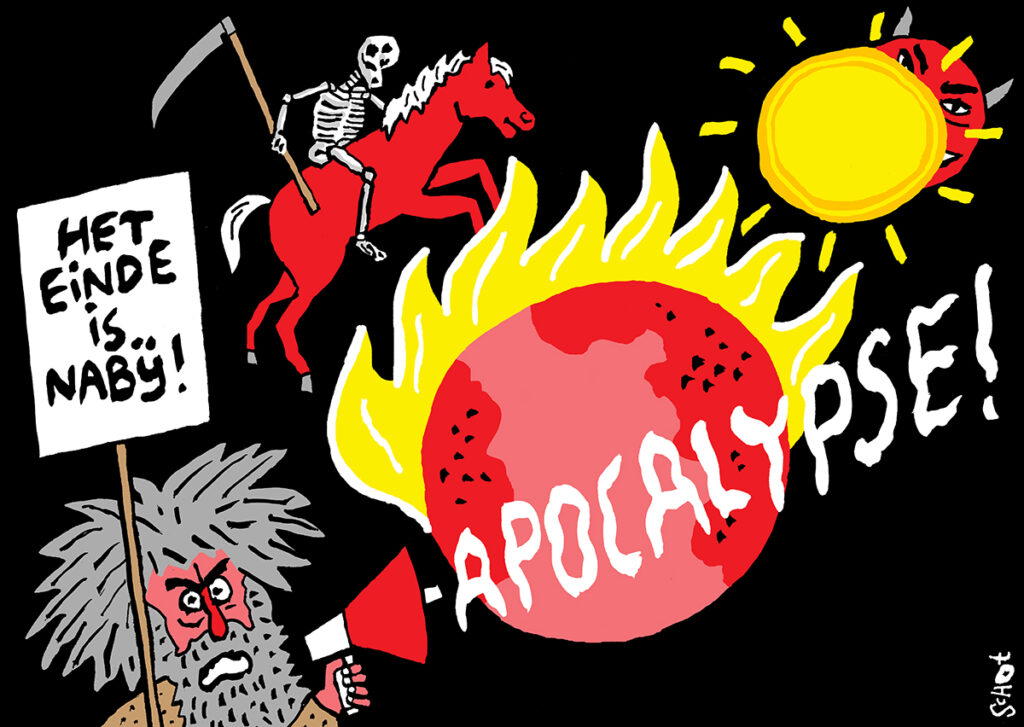Climate pessimists are increasingly turning to biblical symbolism
Apocalyptic images increasingly dominate the debate about climate change. What does that do to us? Tilburg religious scholars are researching the impact of end-time symbolism.

Dark clouds are gathering, raging waves threaten the villages behind the dikes and the sun is setting in a pool of death and destruction. They are unmistakably religiously inspired images. But they are also used by non-religious climate activists to paint a pitch-black picture of the future; A warning if we don’t intervene.
A religiously-inspired undercurrent in green politics had existed in the Netherlands for some time. Think of the Evangelical People’s Party, one of the parties that merged into GroenLinks and Marianne Thieme, Seventh-day Adventist and founder of the Party for the Animals. But lately, religiously-inspired ideas seem to be becoming more and more visible in texts and images disseminated by movies, video games, and social media.
A closer look at the climate debate
Caroline Vander Stichele of the Tilburg School of Catholic Theology (TST) seized the opportunity to submit a research proposal to the Netherlands Organisation for Scientific Research (NWO). The plan: to take a closer look at the influence of religion on the climate debate. ‘It was actually a bit to our surprise that the project was honoured. Of course, Frank and I had focused on a theme that we thought would fit in with the current times.’
Frank is colleague Frank Bosman, affiliated with the same theology faculty, who has done a lot of research on video games. They were struck by how often the word ‘apocalypse’ is used in the climate debate, the term that refers to the ‘end of times’ as it is described in the Bible.
The world is going crazy
The film industry has also contributed to the image in recent decades. Disaster films such as Armageddon managed to sketch a scenario of man’s last days in Technicolor. With the latest digital techniques, Hollywood created a rawly realistic world where the climate goes crazy in films such as The Day After Tomorrow and 2012.
In many of those films, humanity is threatened with extinction. In Deep Impact and Armageddon, alien rocks are the culprits, and the last title even explicitly refers to the Bible. The films are populated by archetypal prophets who are not believed, just like in the religious writings of yesteryear, and heroes who know how to avert disaster with their intransigence and drive for action.
Five minutes to twelve
Climate pessimists like to fall back on this symbolism and there is an obvious reason for that. The fear of the end of time still makes an impression even in these secular times. ‘She is part of the cultural reservoir and those images still resonate today,’ says Vander Stichele.
Ominous beasts, menacing symbols, and diabolical powers populate the last book of the Bible, the Revelation of John. This book, also known as the Apocalypse, has left an enormous mark on Western thought, Caroline Vander Stichele believes, so much so that in these secular times, end-time rhetoric is still understood by everyone.
‘A film like Noah could also be seen as a climate film’
And other books of the Bible also make a contribution; who does not know the story of the flood and Noah’s ark? ‘In that sense, a film like Noah could also be seen as a climate film,’ the theologian acknowledges.
The realization that a climate apocalypse is caused by us humans plays an important role in this choice. The end-time symbolism serves a certain purpose, especially in the climate discussion. Because the gloomy scenarios are being used by climate activists to wake people up. It’s five minutes to twelve, climate prophets warn, it’s high time to take action.
Depressed by the climate
Yet the end-time symbolism can also be counterproductive, Vander Stichele thinks: ‘It can be functional if it gets people moving. Just look at the climate marches. But you also have to watch out for a negative effect when people become depressed or anxious.’
In order to take action, an action perspective is needed. Anyone who thinks that the earth can no longer be saved falls into resignation and passivity. To act purposefully, people need a view of a better future, not a pessimistic message.
The ominous biblical book of Apocalypse also offers such a positive perspective, says Vander Stichele. Because in it, people are ultimately given the choice to improve their lives. ‘It’s actually an encouraging book. It is written to encourage people who are in the midst of a crisis. It says: you have to persevere, even if things go badly, because it will work out in the end.’
International research
In June, the project team presented the first research results within the Dutch context during a symposium. In the coming year, the team will compare these findings with the results of research into expressions by international groups, ranging from Extinction Rebellion to climate deniers. In the autumn of 2025, the team will present these analyses at an international conference at our university.






